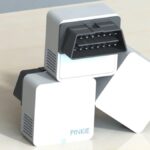Connecting an Android head unit to your car’s OBD2 port opens up a world of data and diagnostics. However, pairing via Bluetooth can be tricky. This guide tackles common issues and provides solutions for successfully connecting your Android device using an “Android Obd2 Bluetooth Code.”
Common OBD2 Bluetooth Pairing Problems with Android Head Units
Many encounter frustration when trying to pair an OBD2 Bluetooth dongle with their Android car stereo. Often, the head unit rejects the pairing code, even if it’s the standard “0000” or “1234.” This issue can stem from compatibility problems between the dongle and the head unit’s Bluetooth stack, or incorrect settings within the Android system. The problem is further compounded by a lack of clear documentation from manufacturers.
Troubleshooting Android OBD2 Bluetooth Pairing
First, ensure your OBD2 dongle is compatible with Android devices. Most modern dongles support the standard ELM327 protocol, which should work with most Android head units. However, some head units may require specific dongle brands or chipsets. Consult your head unit’s documentation or online forums for compatibility information.
Next, access your Android head unit’s Bluetooth settings. This process varies between manufacturers but usually involves navigating to the “Settings” menu and then selecting “Bluetooth.” You may need to enable Bluetooth if it’s currently off.
Once in the Bluetooth settings, put your OBD2 dongle into pairing mode. This typically involves pressing and holding a button on the dongle until an LED light starts flashing. Your head unit should display a list of available devices. Select your OBD2 dongle from the list.
If prompted for a pairing code, try the common codes “0000,” “1234,” or “1111.” If none of these work, consult your dongle’s documentation for the correct code. If the code entry field disappears or you receive an “incorrect code” message, there may be a compatibility issue.
Advanced Troubleshooting Techniques for Android OBD2 Bluetooth
If standard troubleshooting fails, consider these advanced techniques:
-
Hidden Bluetooth Settings: Some Android head units have hidden Bluetooth settings that allow for manual code entry and pairing adjustments. Access these by searching for “Bluetooth” in the head unit’s settings search bar. Look for options to disable “auto connect” and manually input the pairing code.
-
USB Keyboard Input: Using a USB keyboard connected to the head unit can sometimes bypass issues with the on-screen keyboard interrupting code entry.
-
Third-Party OBD2 Apps: Certain OBD2 apps may have built-in pairing functionalities that can override the head unit’s default Bluetooth settings. Explore apps designed for your specific dongle or Android head unit.
-
Firmware Updates: Outdated firmware on your head unit or OBD2 dongle can cause compatibility problems. Check the manufacturer’s websites for updates.
Conclusion: Successfully Pairing Your Android OBD2 Dongle
Pairing an OBD2 dongle with an Android head unit can be challenging, but with persistence and the right techniques, you can unlock access to your car’s data. By understanding common issues and exploring advanced troubleshooting methods, you can successfully connect your devices and utilize the full potential of Android OBD2 diagnostics. If problems persist, consult online forums specific to your head unit or contact the manufacturer for support.
